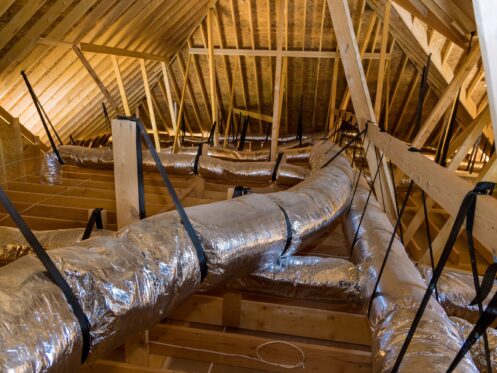When summer arrives, your attic can quickly rise in temperature and feel very uncomfortable. Trapped heat makes your air conditioning equipment work harder, increases your energy bills, and makes this area feel stuffy. With the right insulation and ventilation in place, you can better control heat and humidity. Environmental Heating & Air Solutions in Benicia and Roseville, CA, can help homeowners ensure a comfortable attic space and throughout the rest of the residence.
Why Your Attic Gets Hot During Summer
Attics heat up quickly in the summer and hold that heat. This is especially true if ventilation isn’t adequate. Hot air builds up under your roof and sits just above your ceiling, heating your home from the top down. If there’s not enough airflow in or out of the attic, the temperature can reach 130 degrees Fahrenheit or higher. It doesn’t matter if your thermostat is set at 72 degrees Fahrenheit. That trapped heat can move down into your living spaces and force your AC to run frequently.
Your roof absorbs a lot of heat from the sun. If your attic can’t push that heat back out through vents or pull in cooler air from outside, the temperature keeps climbing. Ventilation works best when it expels hot air to the outside.
How Ventilation Helps Your Home Stay Cooler
The main goal of attic ventilation fans is to let fresh air in and give hot, stale air a place to go. This setup requires the use of intake vents, usually near the bottom of the roof or in soffits, and exhaust vents near the top. Cooler air enters at lower points, while warm air escapes up high. This exchange works best when there’s no blockage and the vents are properly sized for the space.
When ventilation works well, your attic stays closer to the outdoor temperature instead of rising. That means the ceiling on your top floor doesn’t heat up as much, and your air conditioner doesn’t run as hard to cool things down. If you’ve ever noticed your upstairs rooms feel hotter than the rest of the house, your attic airflow might be part of the problem.
Even in homes with newer AC systems, lack of ventilation can prevent optimal comfort. If your attic holds onto heat, no amount of cold air from your vents can keep things comfortable.
Insulation Keeps Heat From Creeping In
While ventilation removes heat, insulation prevents it from passing into your home. The insulation in your attic sits like a blanket across the floor or along the roofline. It works by slowing the movement of heat between spaces. In summer, that also means blocking the heat in your attic from moving into other areas of the home through walls or ceilings.
Insulation isn’t effective if it is old, has a minimal R-value, or is missing entirely. You might feel warm spots in upstairs areas. You may also find it difficult to achieve a cool home on very hot days even if you turn down your thermostat.
New insulation materials are better at stopping heat than older varieties. If your home’s insulation hasn’t been upgraded or updated, it’s worth evaluating your attic to see what your insulation consists of. You might find compacted material or signs of moisture damage. Keep in mind, insulation also helps your home feel warm in the winter.
Replacing Your Attic Insulation
Insulation isn’t designed to last forever. Temperature changes and moisture can break it down over time. If the insulation in your attic is compressed, pulling away from surrounding areas, or doesn’t appear to be filling an entire area, it’s probably not very effective. You should also check for signs of pests, moisture stains, or mold. All these things can damage the material and reduce its performance.
A professional inspection helps confirm whether you need a full replacement or need additional insulation installed. In some cases, adding a fresh layer on top of the old material can boost your insulation level. Other times, the best option is to remove the old material and start fresh with higher R-value insulation that fits your climate, household needs, and roof style.
The Impact of HVAC Equipment
Your attic might feel separate from the rest of your home, but the air from your cooling equipment circulates there. If heat is making its way into your attic, your AC unit must run longer and more often to achieve your desired temperature. This increases your energy bill each month and puts more wear on your system. As your air conditioning system runs more frequently, this can lead to wear and tear on interior components, filters clogging faster, and your HVAC system losing efficiency. Over time, you might start to notice odd sounds, weak airflow, or a system that doesn’t maintain a comfortable indoor temperature like it used to.
Routine AC tune-ups help keep your cooling equipment working efficiently, especially during the hottest months of summer. During a tune-up, a technician can clean coils, test refrigerant levels, and check for any signs of stress from extended use. This maintenance helps stretch the life of your system and gives you better performance daily.
Avoiding DIY Improvements
It might seem tempting to install insulation in your attic yourself or install an exhaust fan, but attic insulation and ventilation systems work best when professional installation is performed. Random upgrades or mismatched products can make things worse. For example, adding insulation without checking for adequate ventilation can trap moisture. This can lead to mold, structural damage, or poor indoor air quality.
The shape and size of your attic, the number of rooflines, and the climate you live in all affect how insulation and ventilation should work together. Depending on your home’s design, you might need a ridge vent, gable vents, or powered attic fans. Achieving the right balance helps you avoid problems.
Signs Your Attic Needs Upgrades
You may not go in your attic much, but you may notice signs in the rest of your home that indicate poor attic ventilation or insulation issues. If the upper levels of your home feel hotter than the rest of the house, or your summer energy bill keeps rising, heat may be getting trapped in your attic. Pay attention to how fast your house warms up after the AC turns off. That heat could come from your attic if you’re noticing it doesn’t stay cool for long.
You might also notice little things, like peeling paint near ceiling vents, a musty smell near the attic door, or areas of your ceiling that feel warmer than others. You may feel warm air coming down from the attic hatch. These signs might seem small, but they can mean your attic isn’t doing a great job of removing heat.
Planning an Attic Upgrade
Homeowners often wonder how often insulation should be replaced. Most insulation loses effectiveness after about 15 to 20 years. If you’ve noticed your air conditioning unit running longer than normal or your home feels warmer than usual, your insulation might need attention. It helps to plan an insulation and ventilation upgrade together. These two systems support each other.
Upgrade Your Attic Today
Environmental Heating & Air Solutions offers attic insulation upgrades, ventilation improvements like whole-house fans, home energy audits, air sealing, HVAC system assessments, ductwork repairs, radiant barrier installations, indoor air quality testing, and whole-home energy efficiency solutions. Whether you need improved airflow, additional insulation, or an inspection, small attic upgrades can go a long way.
Let Environmental Heating & Air Solutions help you achieve optimal insulation and ventilation in your Roseville or Benicia home today.

